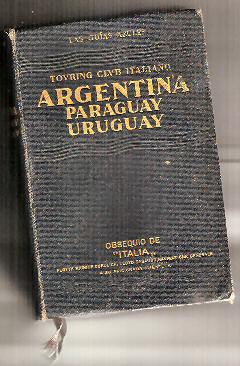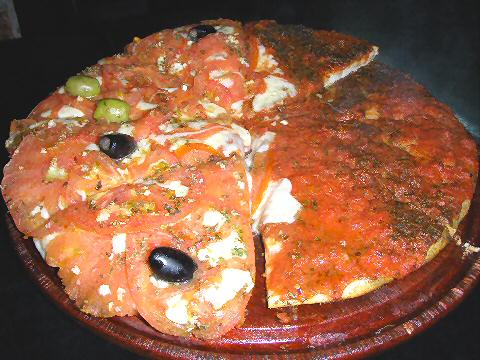“I agree with you that it is the duty of every good citizen to use all the opportunities, which occur to him, for preserving documents relating to the history of our country.”
– Thomas Jefferson, 3rd President of the United States
 Buenos Aires – Anyone who travels extensively, especially in Europe, is probably familiar with the Blue Guide line of guidebooks. In some ways, not as “friendly” as your average guidebook, they’re packed, instead, with detailed travel information, historical notes, self-guided tours, maps, and an amazing amount of detail. They’re designed for someone who is a “traveler” versus someone who is a “tourist”, and there’s a big difference. The modern versions of those guides don’t include anything covering South America, but at one time, in their early days, they did, and by chance, while rummaging through a flea market, I found a copy of the 1932 Argentina, Uruguay, and Paraguay edition, in Spanish. Having just started flipping through it, I can say it’s a fascinating glimpse into a 75 year-old past, and a very different world. So, expect that over the next weeks, months… I’ll be taking portions from the touring, especially things like the historical restaurants and cafes, and taking a look at whatever happened to them, what they are now, etc. I’ve already noted that a few of the places are still in existence, and a few have moved location but are still around, and some, I know, are simply gone – it will be interesting to see…
Buenos Aires – Anyone who travels extensively, especially in Europe, is probably familiar with the Blue Guide line of guidebooks. In some ways, not as “friendly” as your average guidebook, they’re packed, instead, with detailed travel information, historical notes, self-guided tours, maps, and an amazing amount of detail. They’re designed for someone who is a “traveler” versus someone who is a “tourist”, and there’s a big difference. The modern versions of those guides don’t include anything covering South America, but at one time, in their early days, they did, and by chance, while rummaging through a flea market, I found a copy of the 1932 Argentina, Uruguay, and Paraguay edition, in Spanish. Having just started flipping through it, I can say it’s a fascinating glimpse into a 75 year-old past, and a very different world. So, expect that over the next weeks, months… I’ll be taking portions from the touring, especially things like the historical restaurants and cafes, and taking a look at whatever happened to them, what they are now, etc. I’ve already noted that a few of the places are still in existence, and a few have moved location but are still around, and some, I know, are simply gone – it will be interesting to see…
Now, in the historical vein, though not out of the book, there’s been a spot that’s been “on my list” for a long time. The place has acquired something of a mystique, and I’m not entirely clear why. The place, Angelín, at Cordoba 5270, in Villa Crespo (on the line with Palermo). I hear stories of them using “secret” types of wood in their wood-fired oven, of just as secret recipes for their crust and their sauce. They’re famous for their pizza canchera (which means “savvy” or “streetwise”), which they claim to have invented – it’s a pizza with just dough and sauce… no cheese, no other toppings… I’m afraid I can’t go along with giving them credit for having “invented” such a thing – perhaps they were the first in Buenos Aires to serve a pizza with just dough and sauce, but long before their was an Argentina, the Italians were doing the same thing back in Napoli… and, perhaps, most importantly for some, they are legendary for being “Frank Sinatra’s favorite”, right down to an autographed photo on their wall from him… which doesn’t affirm his favor, just that he’d tried their pizza… and a bit of digging turns up that Frankie only graced Argentina with one visit in his career, in August 1981, where he put on five performances over five nights. I can’t say how many of those nights he graced Angelín with his presence, or if, perhaps, he simply had the pizza delivered to his hotel, but it would seem to me that five days is a bit short to have decided on a favorite pizza in the city. But, such are the few threads of which legends are woven, no?

Dan,
You’re right, “canchero/a” means savvy, streetwise. But in this case, “pizza canchera” or “pizza de cancha” is what was sold near the futbol (soccer) stadiums (stadia?). Oversized and cold. And accompanied with a slice of “fainá” (made of chickpea flour).
Gustavo
Ah, good to know, and I assume that’s why they use it to refer to the really extra large size (which, however, appeared to be piping hot…) – though, it doesn’t quite explain why it refers to the style as well, without cheese, unless it was just easier to sell it cold at the stadium without congealed mozzarella…. I did, by the way, try a slice of their fainá as well, and it wasn’t bad – again, I’ve had better, but I’ve also had worse.
Angelin is way far the best pizza I’ve had in Buenos Aires. I loved the style old fashioned and casual, and the flavors …The cnachera pizza is just unique; the wine seleccion was ok. Do not forget the desserts ! That riccotta torte was the best cremy cheese cake ever!!!
Veronica
[…] then scattered with herbs and garlic. The name, as was explained to me by a local reader after I first discovered the style comes from the ambient temperature pizzas that used to be sold more or less tailgate fashion […]
[…] on my pizza map, with all my samplings, I’ve only been to two other pizzerias in the barrio, Angelín, and 1893. The former is more or less the same style, I think I like this better, though it’s […]